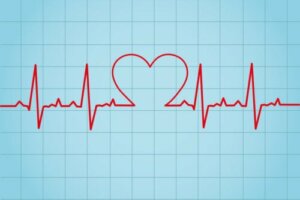Heart Rate: What Is It and How Is It Measured?


Written and verified by the biologist Samuel Antonio Sánchez Amador
Heart rate is the number of heart contractions or beats per unit of time. It’s taken under well-determined physiological conditions and is expressed in beats per minute (beats/min).
The speed of your heartbeat depends on many factors, like physical activity, threats to safety, and individual emotional responses. As you can imagine, your heart rate is very different in a traffic accident or when you’re resting in bed.
If you want to know everything about this vital sign, keep reading.
What is a heart rate?
As stated by the American Heart Association, your heart rate is the number of times your heart beats per minute. This tireless organ pumps 70 milliliters of blood with each heartbeat, about 5 liters in 60 seconds. To do this, your muscles need to contract and relax rhythmically.
On a physical level, it’s cyclical. This means that it is repeated in a specific amount of time. Although a normal heart rate doesn’t ensure that you’re disease-free, it’s a useful parameter to identify a wide variety of disorders.
According to the World Health Organization (WHO), ischemic heart disease is the leading cause of death in the world in high-income countries, far above cancers and other types of disease. It accounts for 47% of all deaths, and in the United States, about 647,000 Americans die from it annually.
Without a doubt, paying attention to the heart can save lives!

To learn more: Support Your Heart with Six Types of Low Sodium Food
How is heart rate measured?
The United States National Library of Medicine shows us the most effective ways to measure heart rate. In general, you can measure your pulse in areas where the arteries pass close to the skin.
Some viable sites for this are your wrist, the top of your foot, temple, neck, and groin. The most common way to check your heart rate at home is from your wrist.
To do this, you need to perform the following steps:
- Gently press the inside of your wrist on the side of your thumb. You’ll notice the radial artery under your skin, which runs through the radial canal.
- Place your index and middle fingers about half an inch below the crease of your wrist, between the bone that projects outward and the tendon on the inner side.
- As soon as you feel the first heartbeat, start counting the number that occurs in 60 seconds with the help of a stopwatch. You can also count the beats in 30 seconds, then multiply them by 2, but there may be more errors in this method.
If you don’t want to do it manually, don’t worry. Many devices that measure your blood pressure (like a wrist monitor) also indicate the patient’s heart rate on the digital display. Using these gadgets is straightforward and it doesn’t take more than a couple of minutes to get the results.
What’s the normal heart rate?
Maybe you’re here to find the answer to this question. Each person’s individual heart rate depends on many factors, but we’ll show you the normal results in 2 very specific situations: rest and exercise.
Standby frequency
According to the American Heart Association, your resting heart rate is the one that pumps the least amount of blood needed, since you’re not exercising. While lying down and relaxed, the average heart rate is between 60 and 100 beats per minute.
However, a rate less than 60 beats per minute is not always a sign of disease. For example, patients taking beta-blocker drugs have lower frequencies. They are prescribed, above all in heart rhythm disorders and to protect the heart after a heart attack.
On the other hand, a person who exercises a lot may also have a heart rate below 60. This is because the heart muscle is in good shape and doesn’t need to work as hard to maintain a stable heartbeat.
The normal resting rate varies greatly depending on the age of the patient. Here’s a list with the expected values according to the group:
- Newborns 0 to 1 month: 70-190 beats/min.
- Babies 1 to 11 months: 80-160 beats/min.
- Children 1 to 2 years: 80-130 beats/min.
- Children 3 to 4 years: 80-120 beats/min.
- Children 5 to 6 years: 75-115 beats/min.
- Children 7 to 17 years: 70-110 beats/min.
- Adults: 60-100 beats/min.
- Well-trained adults or professional athletes: 40-60 beats/min.
In fact, children have higher heart rates because their hearts haven’t fully developed. Myocytes (heart cells) are smaller and unorganized. Therefore, they shrink less. To pump the necessary amount of blood, it needs to beat more times.
Frequency during exercise
During physical activity, your heart should beat faster. Muscles need more nutrients and oxygen since they are expending energy, so more blood has to reach them in the same amount of time.
Therefore, it’s normal for your heart rate to be around 150-200 beats per minute while working out.
What factors can affect your heart rate?
Many factors can affect your heart rate, beyond exercise and rest. Some of the sources we mentioned show us some parameters that can cause a healthy person’s heart rate to be abnormal.
1. Air temperature
Generally speaking, with a room temperature between 60 and 75 degrees, the heart rate can increase normally between 2 and 4 beats per minute. If the temperature is around 76-80 degrees, the frequency can increase by up to 10 beats per minute.
2. Position
Whether you’re sitting or standing while resting, your heart rate is usually the same. However, if you take your pulse right after sitting up, it may be a little higher than normal. Therefore, it’s best to wait a couple of minutes after getting up to take this measurement.
3. Emotions
Anxiety, stress, and other emotions can increase your heart rate. Tachycardia can happen when your pulse reaches 130-140 beats per minute. Psychological help and learning relaxation techniques are usually the best tools to deal with these situations.
4. Weight
Weight doesn’t affect heart rate. However, if the patient has a very high body mass index, the resting pulse may be higher than normal. After all, in obese people, the heart needs to work harder for the blood to go around the whole body.

5. Medications
As we mentioned earlier, beta-blockers slow down the heart rate in patients with a fragile heart. On the other hand, taking thyroid drugs can increase it.
You might be interested: Work Stress Associated with Risk of Heart Attack
Check your own pulse
As you can see, your heart rate is a vitally important parameter that provides lots of information about a patient’s immediate health status. However, the number of beats per minute does not necessarily mean that you don’t have any disease or condition.
In any case, we recommend that you go to the doctor if you notice that your pulse is much higher or lower than normal. Although it may not be an issue, it’s better safe than sorry.
All cited sources were thoroughly reviewed by our team to ensure their quality, reliability, currency, and validity. The bibliography of this article was considered reliable and of academic or scientific accuracy.
- Frecuencia cardíaca, Fundación Española del Corazón. Recogido a 23 de febrero en https://fundaciondelcorazon.com/prevencion/riesgo-cardiovascular/frecuencia-cardiaca.html
- Las 10 principales causas de defunción, OMS. Recogido a 23 de febrero en https://www.who.int/es/news-room/fact-sheets/detail/the-top-10-causes-of-death
- ROLANDI, FLORENCIA. “Betabloqueantes en la insuficiencia cardiaca.” Rev Argent Cardiol 70 (2002): 218-230.
- Frecuencia cardíaca, Medlineplus.gov. Recogido a 23 de febrero en https://medlineplus.gov/spanish/ency/article/003399.htm
- Todo acerca de la frecuencia cardíaca (pulso), GoRedforWomen. Recogido a 23 de febrero en https://www.goredforwomen.org/es/health-topics/high-blood-pressure/the-facts-about-high-blood-pressure/all-about-heart-rate-pulse#:~:text=La%20frecuencia%20card%C3%ADaca%20en%20reposo,100%20
This text is provided for informational purposes only and does not replace consultation with a professional. If in doubt, consult your specialist.








